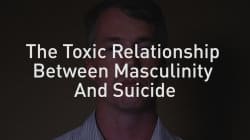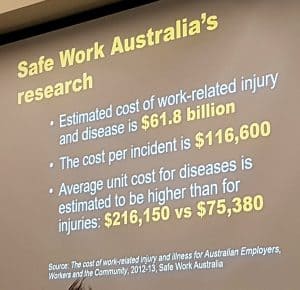Being a member of a local safety group provides nuggets of occupational health and safety (OHS) information from speakers and members in a broad range of industries and occupations. The May 2017 meeting of the Central Safety Group at which Wayne Richards spoke provoked several OHS thoughts about safety, leadership and culture. One was that Transdev…
Category: ethics
Real men and work-related suicide
 Recently Huffington Post Australia posted a video about male suicides called “Men are killing themselves to be real men”. Many of the speakers talked about their experiences at work or with work. The video is highly recommended.
Recently Huffington Post Australia posted a video about male suicides called “Men are killing themselves to be real men”. Many of the speakers talked about their experiences at work or with work. The video is highly recommended.
SafetyAtWorkBlog had the opportunity to talk with the Associate Video Editor, Emily Verdouw. Below is an edited transcript.
Trade unions offer alternative, more accurate(?) workplace death statistics
 The Victorian Trades Hall Council (VTHC) indirectly acknowledged the ILO theme for World Day for Safety and Health at Work in its media release for International Workers Memorial Day 2017. The ILO was calling for more, and better, data on workplace injuries and illnesses. VTHC questioned the official workplace fatality numbers issued by the government. It stated:
The Victorian Trades Hall Council (VTHC) indirectly acknowledged the ILO theme for World Day for Safety and Health at Work in its media release for International Workers Memorial Day 2017. The ILO was calling for more, and better, data on workplace injuries and illnesses. VTHC questioned the official workplace fatality numbers issued by the government. It stated:
“A VTHC analysis shows that in 2016-17 over 200 Victorians died as a direct result of Workplace injury or illness, although the government’s official tally for the year is just 26.”
This disparity needs to be discussed across jurisdictions because occupational health and safety (OHS) data has always been incomplete, a fact acknowledged by many government inquiries in Australia for many years.
Asbestos – out of sight but not out of mind in Asia
By Melody Kemp

Asbestos resembles polio. Just when you think it’s beaten, it returns like some ghoul. If you think this is overly dramatic, last year Laos was struck by a polio outbreak. This year we learned that Laos now ranks amongst the globe’s major importers of asbestos. And it’s driven by cynical market forces targeting poorer nations, inadvertently promoted by international aid. Continue reading “Asbestos – out of sight but not out of mind in Asia”
Big business seminar adds to OHS knowledge library
 The latest broadcast in Safe Work Australia’s Virtual Safety Seminar (VSS) series is aimed at the executive level of management and entitled “Why big business needs to lead work health and safety“. One of the attractions of the VSS is that Safe Work Australia is able to draw upon senior and prominent business leaders who do not often talk occupational health and safety.
The latest broadcast in Safe Work Australia’s Virtual Safety Seminar (VSS) series is aimed at the executive level of management and entitled “Why big business needs to lead work health and safety“. One of the attractions of the VSS is that Safe Work Australia is able to draw upon senior and prominent business leaders who do not often talk occupational health and safety.
This seminar included contributions from Diane Smith-Gander, Dean Pritchard, Marcus Hooke and was hosted by Jennifer Hewett.
Several important perspectives were discussed that would be helpful to the intended audience but there were also some comments that deserve contemplation.
Discussing risk assessments should lead to an analysis of the ethics of OHS
 Recently a Young Safety Professional network in Queensland conducted a debate or discussion about the role of risk assessment in occupational health and safety (OHS). Naomi Kemp posted an article about the event titled “To risk assess, or not to risk assess: that is the question“. Risk assessments offer an entry point to broader discussions of liabilities, risk, red tape, complacency, communication and state of knowledge. But of most relevance to OHS compliance is that risk assessments are part of the legal obligation to consult.
Recently a Young Safety Professional network in Queensland conducted a debate or discussion about the role of risk assessment in occupational health and safety (OHS). Naomi Kemp posted an article about the event titled “To risk assess, or not to risk assess: that is the question“. Risk assessments offer an entry point to broader discussions of liabilities, risk, red tape, complacency, communication and state of knowledge. But of most relevance to OHS compliance is that risk assessments are part of the legal obligation to consult.
When Work Kills – new research on workplace suicides
 There are many advocates of the importance of a mental health and wellbeing in workplaces. But few of them address the worst-case scenario for workplace mental health of work-related suicides. In some cases, the mental health advocates are overly cautious about even speaking the reality, which does not help reduce mental health stigma.
There are many advocates of the importance of a mental health and wellbeing in workplaces. But few of them address the worst-case scenario for workplace mental health of work-related suicides. In some cases, the mental health advocates are overly cautious about even speaking the reality, which does not help reduce mental health stigma.
In 2016 Professor Stewart Clegg, of UTS Business School said that
“That work can kill the will to live is a fundamental ethical problem that we must attend to…”
New research from the UK provides a useful summary of the work-related and workplace suicides in Europe with important lessons of where precarious employment and the “gig economy” could lead.
